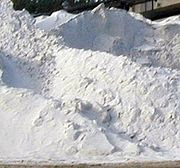 Pure silica (SiO2) has a "glass melting point"— at a viscosity of 10 Pa·s (100 P)— of over 2300 °C (4200 °F). While pure silica can be made into glass for special applications, other substances are added to common glass to simplify processing.
Pure silica (SiO2) has a "glass melting point"— at a viscosity of 10 Pa·s (100 P)— of over 2300 °C (4200 °F). While pure silica can be made into glass for special applications, other substances are added to common glass to simplify processing.One is sodium carbonate (Na2CO3), which lowers the melting point to about 1500 °C (2700 °F) in soda-lime glass; "soda" refers to the original source of sodium carbonate in the soda ash obtained from certain plants.
However, the soda makes the glass water soluble, which is usually undesirable, so lime (calcium oxide (CaO), generally obtained from limestone), some magnesium oxide (MgO) and aluminium oxide are added to provide for a better chemical durability.
The resulting glass contains about 70 to 74 percent silica by weight and is called a soda-lime glass. Soda-lime glasses account for about 90 percent of manufactured glass.
Sand is a naturally occurring granular material composed of finely divided rock and mineral particles.
As the term is used by geologists, sand particles range in diameter from 0.0625 (or 1⁄16 mm, or 62.5 micrometers) to 2 millimeters. An individual particle in this range size is termed a sand grain. The next smaller size class in geology is silt: particles smaller than 0.0625 mm down to 0.004 mm in diameter.
The next larger size class above sand is gravel, with particles ranging from 2 mm up to 64 mm . Sand feels gritty when rubbed between the fingers (silt, by comparison, feels like flour).
ISO 14688 grades sands as fine, medium and coarse with ranges 0.063 mm to 0.2 mm to 0.63 mm to 2.0 mm. In USA, sand is commonly divided into five sub-categories based on size: very fine sand (1/16 - 1/8 mm diameter), fine sand (1/8 mm - 1/4 mm), medium sand (1/4 mm - 1/2 mm), coarse sand (1/2 mm - 1 mm), and very coarse sand (1 mm - 2 mm).
These sizes are based on the Krumbein phi scale, where size in Φ = -log base 2 of size in mm. On this scale, for sand the value of Φ varies from -1 to +4, with the divisions between sub-categories at whole numbers.




No comments:
Post a Comment